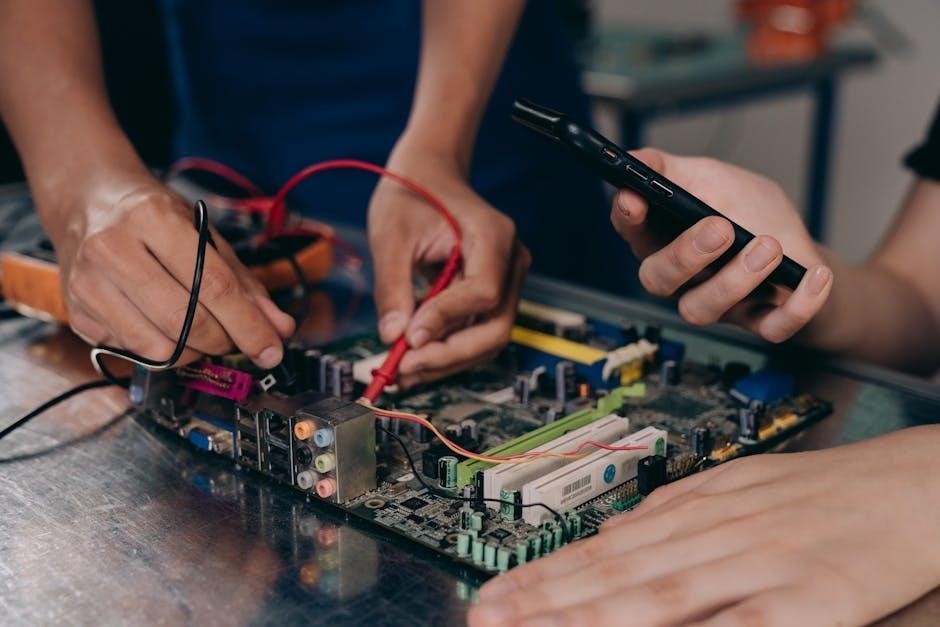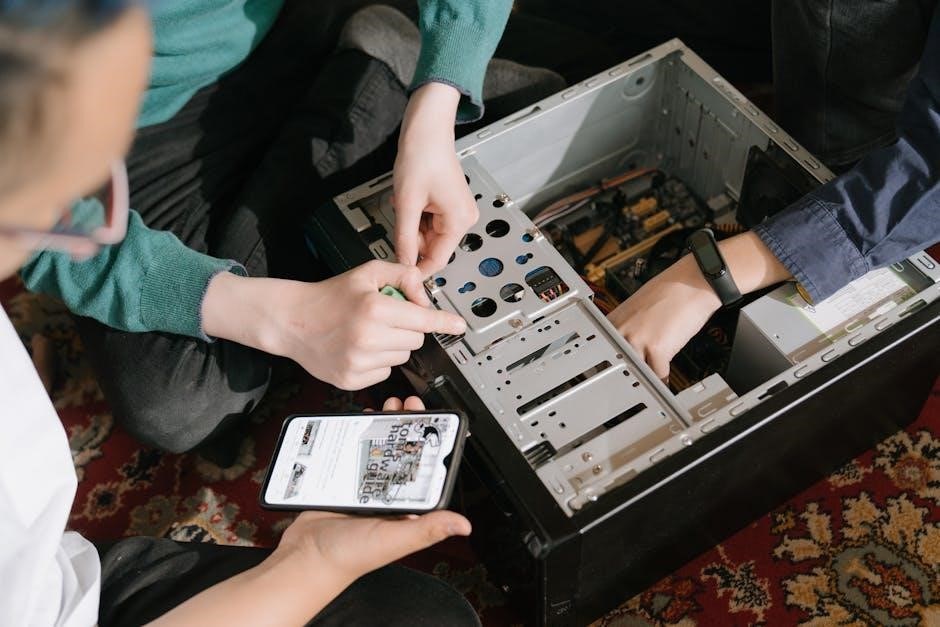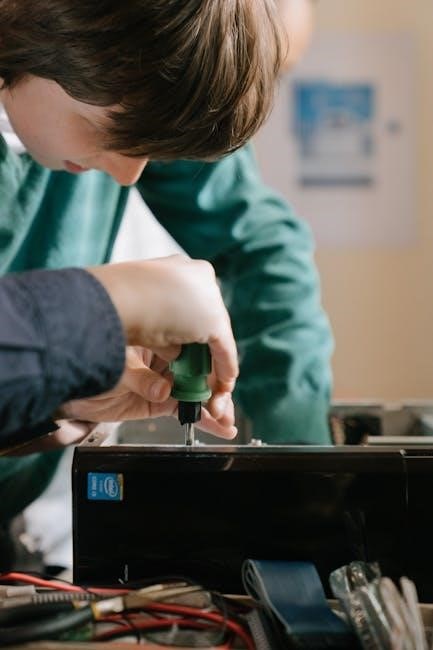modine heaters troubleshooting guide
Summary
Fix your Modine heater issues with our expert troubleshooting guide. Learn how to diagnose and repair common problems quickly and efficiently.

Welcome to the Modine Heaters Troubleshooting Guide, your comprehensive resource for diagnosing and resolving common issues with Modine heating units. This guide provides expert tips, step-by-step solutions, and safety guidelines to help you identify and fix problems efficiently, ensuring optimal performance and longevity of your heater.
1.1 Overview of Common Issues and Solutions
Modine heaters often face issues like ignition failure, thermostat malfunctions, and airflow restrictions. Common solutions include checking circuit breakers, inspecting venting systems, and ensuring proper gas supply. Addressing these problems promptly can prevent further damage and extend the heater’s lifespan. This guide provides detailed steps to diagnose and resolve these issues effectively, ensuring your Modine heater operates safely and efficiently throughout the year.

Common Ignition-Related Problems
Ignition issues in Modine heaters often stem from faulty igniters or pressure switches. Troubleshooting involves checking the gas supply, igniter condition, and electrical connections for proper function.
2.1 Igniter Failure and Replacement
A faulty igniter is a common issue in Modine heaters, often causing the unit to fail to heat. If the igniter doesn’t glow or spark, replace it with a factory-approved part. Turn off power and gas supply before starting the replacement. Clean the combustion chamber to ensure proper ignition. Refer to the user manual for specific instructions to avoid further complications and ensure safe operation.
2.2 Combustion Chamber Pressure Switch Issues
The combustion chamber pressure switch ensures proper airflow and safe operation. If it fails to close, the heater won’t ignite. This often occurs due to venting issues or blockages. To troubleshoot, inspect the venting system for obstructions or damage. Clean or replace the venting components as needed. If the issue persists, the pressure switch may need replacement with a factory-approved part. Always follow safety guidelines and manual instructions when performing repairs.
Thermostat and Temperature Control Issues
Thermostat issues can prevent proper heating. Check for faulty thermostats, wiring problems, or loose connections. Ensure the thermostat is correctly set and functioning. Replace if necessary.
3.1 Faulty Thermostat Troubleshooting
Troubleshoot a faulty thermostat by first ensuring it is set correctly. Check for loose or damaged wires and connections. If issues persist, test the thermostat by bypassing it or using a jumper wire. Replace the thermostat if it fails to respond or maintain consistent temperatures. Always ensure compatibility with your Modine heater when installing a new thermostat.
3.2 Wiring and Electrical Connections
Inspect wiring and electrical connections for damage or wear. Verify that all terminals are securely connected and free from corrosion. Check the circuit breaker or fuse to ensure power is supplied. Use a multimeter to test voltage at the thermostat and heater terminals. Loose or faulty connections can cause intermittent operation or complete system failure, so ensure all components are properly wired and grounded for safe and efficient operation.
Airflow Restrictions and Venting Problems
Inspect vent pipes for blockages and ensure proper installation. Clean or replace clogged filters and vents. Check for damaged or disconnected ducts. Addressing airflow issues promptly prevents reduced efficiency and potential safety hazards.
4.1 Venting System Inspection and Cleaning
Regularly inspect the venting system for blockages, dirt, or rust. Clean vent pipes and ensure proper installation to maintain airflow. Check for signs of damage or disconnection and address them promptly; Clearing obstructions prevents reduced efficiency and potential safety hazards. Use approved cleaning tools to remove debris and ensure all connections are secure. This step is crucial for maintaining proper heater operation and safety standards.
4.2 Fan and Limit Switch Malfunctions
Fan and limit switch malfunctions can disrupt airflow and heating performance. Check for dust buildup or obstruction in the fan assembly. Test the limit switch by bypassing it temporarily or replacing it if faulty. Ensure proper voltage supply to the fan motor. If the fan doesn’t operate, inspect wiring connections or replace the switch. Addressing these issues promptly restores airflow and prevents overheating, ensuring safe and efficient heater operation.

Electrical and Circuit-Related Issues
Identify and resolve electrical issues like tripped circuit breakers, faulty transformers, or loose wiring. Ensure proper power supply and check for shorts or overloads. Addressing these problems is crucial for safe and efficient heater operation.
5.1 Circuit Breaker and Power Supply Checks
Start by checking the circuit breaker or fuse box to ensure the heater’s circuit hasn’t tripped or blown. Verify that the power supply to the unit is stable and meets the manufacturer’s specifications. Inspect wiring connections for damage, corrosion, or loose ends. If issues persist, consult a licensed electrician to rule out electrical system faults. Always turn off power before performing diagnostics to ensure safety.
5.2 Control Board and Transformer Problems
If the heater’s control board or transformer malfunctions, it can disrupt operation. Check for blown fuses or tripped breakers connected to the control system. Look for signs of physical damage, such as burn marks or loose connections. If issues persist, replace the faulty components with factory-approved parts. Always disconnect power before servicing to avoid electrical hazards. Consult a professional if you’re unsure about repairs.

Heater Lockout and Reset Procedures
Heater lockouts occur due to safety mechanisms detecting issues like ignition failures or pressure switch problems. Resetting involves disconnecting power or addressing the root cause.
6.1 Understanding Soft and Hard Lockouts
A soft lockout is a temporary shutdown, often due to minor issues like a failed ignition sequence or brief power interruptions. The heater resumes operation once the problem is resolved. A hard lockout, however, indicates a more serious issue, such as a persistent ignition failure or a malfunctioning pressure switch, requiring manual intervention to reset the system. Both are safety features designed to protect the unit and user from potential damage or hazards. Understanding the difference between soft and hard lockouts is crucial for effective troubleshooting and ensuring safe operation. Regular maintenance can help prevent frequent lockouts, while prompt repairs address underlying causes, restoring heater functionality efficiently. Always refer to the manufacturer’s guidelines for reset procedures to avoid complications. Proper handling of lockouts enhances the lifespan and reliability of your Modine heater.
6.2 Manual Reset Procedures
To manually reset your Modine heater, first ensure the unit is powered off. Remove the main power supply for at least 30 seconds to clear any stored errors. Alternatively, disconnect the thermostat call for heat by switching it to the “off” position and waiting a minute. After resetting, restore power or reconnect the thermostat and observe if the heater resumes normal operation. Always follow safety guidelines and consult the manual for specific reset instructions tailored to your model. This procedure can resolve both soft and hard lockouts, restoring functionality without advanced tools. Regular resets can prevent prolonged downtime, but if issues persist, professional assistance may be necessary to address underlying faults.
Fuel Supply and Gas-Related Issues
Address gas valve malfunctions, propane/natural gas adjustments, and fuel supply blockages. Ensure proper gas flow and pressure, and inspect for leaks or obstructions. Consult the manual for specific adjustment tips to maintain efficient combustion and safety.
7.1 Gas Valve Malfunctions
Gas valve malfunctions can prevent proper fuel flow, causing ignition issues. Check for blockages, wear, or incorrect adjustments. Ensure the valve is clean and functioning correctly. If faulty, replace it with an approved part. Verify the power supply and wiring connections to the valve. Consult the manual for specific adjustment procedures to restore optimal gas flow and combustion efficiency. Addressing these issues promptly ensures safe and reliable heater operation.
7.2 Propane and Natural Gas Adjustment Tips
Properly adjusting your Modine heater for propane or natural gas ensures efficient operation. For propane, ensure the orifice is correctly installed and consult the manual for specifications. Adjust the air shutter to achieve a clean blue flame. For natural gas, verify manifold pressure settings and ensure the gas valve is configured correctly. Regularly test gas flow and connections to prevent leaks. Annual inspections and adjustments are recommended to maintain optimal performance and safety standards.
Error Codes and Diagnostic Lights
This section explains Modine heater error codes and diagnostic lights, helping you quickly identify issues like igniter failure or pressure switch problems for efficient troubleshooting.
8.1 Common Error Codes Explained
This section covers common error codes displayed by Modine heaters, such as E1, E2, and E3, which indicate issues like igniter failure, pressure switch problems, or gas supply malfunctions. Understanding these codes helps diagnose problems quickly. For example, E1 often points to an igniter issue, while E2 may signal a faulty pressure switch. Referencing the error code chart in your manual ensures accurate troubleshooting and repairs, helping restore your heater’s functionality efficiently.
8.2 Interpreting Diagnostic LED Lights
Modine heaters use diagnostic LED lights to indicate specific issues. These lights flash in patterns to signal malfunctions, such as igniter failure or pressure switch problems. For example, two flashes may indicate a faulty igniter, while three flashes could point to a pressure switch issue. Refer to your heater’s manual to decode the flash patterns, enabling you to identify and address the root cause of the problem efficiently and safely.

Maintenance Tips for Preventing Issues
Regularly clean filters, inspect vents, and check electrical connections to ensure optimal performance. Schedule annual professional inspections to prevent major issues and extend your heater’s lifespan.
9.1 Regular Maintenance Schedule
Adhere to a routine maintenance schedule to prevent Modine heater issues. Inspect filters monthly and replace them as needed. Clean the combustion chamber and venting system seasonally. Check electrical connections and gas lines for leaks quarterly. Schedule annual professional inspections to ensure optimal performance and safety. Regular lubrication of moving parts and calibration of gas valves can also prevent premature wear and tear, ensuring your heater runs efficiently year-round.
9.2 Cleaning and Replacing Filters
Regularly cleaning and replacing filters is crucial for maintaining your Modine heater’s efficiency. Dirty filters can restrict airflow, leading to reduced performance and increased energy consumption. Turn off the power before removing and cleaning filters with mild soap and water. Replace filters every 1-3 months or as recommended by the manufacturer. Properly fitted and clean filters ensure consistent heating and prevent potential system damage, promoting reliable operation and improved air quality.
Safety Guidelines and Precautions
Always turn off power before servicing. Ensure proper ventilation to prevent gas buildup. Handle flammable materials cautiously and follow manufacturer guidelines to avoid accidents and ensure safe operation.
10.1 Safety Checks Before Troubleshooting
Before troubleshooting your Modine heater, ensure the area is well-ventilated and free from flammable materials. Turn off the power supply and allow the unit to cool. Check for gas leaks using a detector or soap solution. Never attempt repairs without proper tools and protective gear. If unsure, consult a certified technician to avoid accidents and ensure compliance with safety standards.
10.2 Handling Gas Leaks and Emergencies
If a gas leak is suspected, immediately turn off the heater and main gas supply. Open windows for ventilation but avoid sparks or open flames. Do not operate electrical switches. Contact a certified technician or emergency services if the odor persists. In case of emergencies, evacuate the area and follow safety protocols to prevent accidents and ensure a safe resolution to the situation.
By following this guide, you can identify and resolve Modine heater issues effectively. Regular maintenance and prompt repairs ensure safety, efficiency, and extend the unit’s lifespan.
11.1 Summary of Key Troubleshooting Steps
Identify common issues like ignition failure or airflow restrictions. Check circuit breakers, gas valves, and venting systems. Reset the heater if locked out and inspect wiring for faults. Regular maintenance, such as cleaning filters, prevents many problems. Always refer to the user manual for specific guidance and ensure safety during repairs. Addressing issues promptly enhances efficiency and extends the heater’s lifespan.